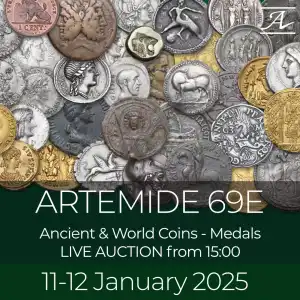

Greek Italy. Southern Apulia, Tarentum. AR Nomos, c. 510-500 BC. Obv. Phalanthos riding dolphin right, extending left hand, right hand resting on dolphin’s back; TARAS (retrograde) to left, scallop shell below, dot-and-cable border around. Rev. Incuse of obverse type; radiate border around. HN Italy 826; HGC 1 752; Vlasto 64-5; Weber 511. 7.26 g. 24.5 mm. RR. Very rare and attractive early issue, well centred. About VF. Dating from the late sixth century BC, this nomos features the figure of Phalanthus, depicted nude and riding a dolphin—a motif that became a central iconographic element in the coinage of Taras. The scene represents the legendary dolphin’s conveyance of Phalanthus across the sea to Italy, following the guidance of the Delphic oracle. The presence of a pecten shell in the lower field symbolically reinforces this maritime journey.
According to Pausanias’ Periegesis (2nd century AD), statues of Taras, Phalanthus, and the dolphin (cf. Paus. X 13) were among the votive offerings (anathemata) dedicated to Delphi by the Tarantines, constructed from a fifth of the spoils captured from the Peucetii and Iapygians.
The reverse of this coin mirrors the obverse, rendered in incuse—a numismatic technique typical of early coinage from Southern Italy, including Taras and other important cities in the region. This incuse method, a hallmark of archaic coin production, highlights the technical sophistication of Tarentine die engravers and their adherence to early coinage traditions.
According to Pausanias’ Periegesis (2nd century AD), statues of Taras, Phalanthus, and the dolphin (cf. Paus. X 13) were among the votive offerings (anathemata) dedicated to Delphi by the Tarantines, constructed from a fifth of the spoils captured from the Peucetii and Iapygians.
The reverse of this coin mirrors the obverse, rendered in incuse—a numismatic technique typical of early coinage from Southern Italy, including Taras and other important cities in the region. This incuse method, a hallmark of archaic coin production, highlights the technical sophistication of Tarentine die engravers and their adherence to early coinage traditions.


